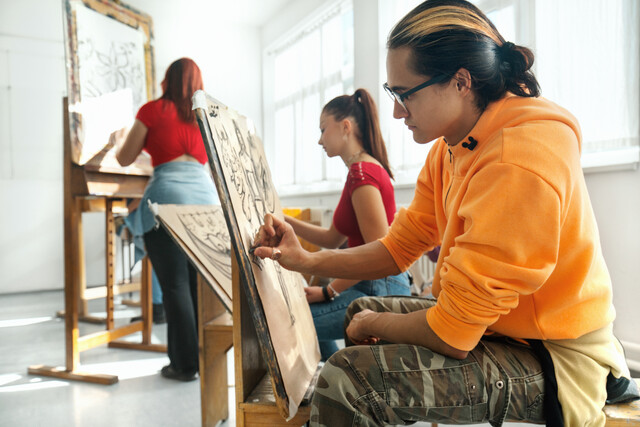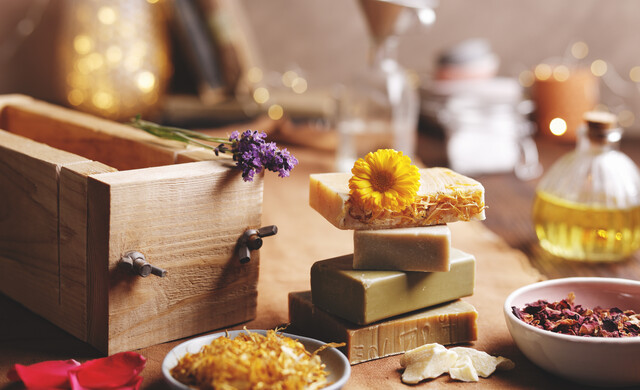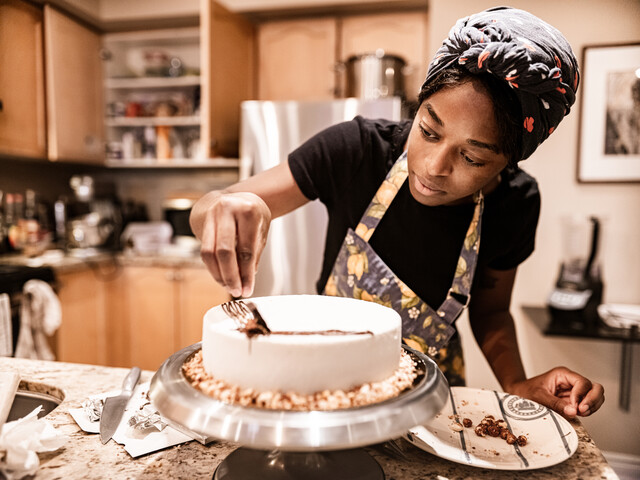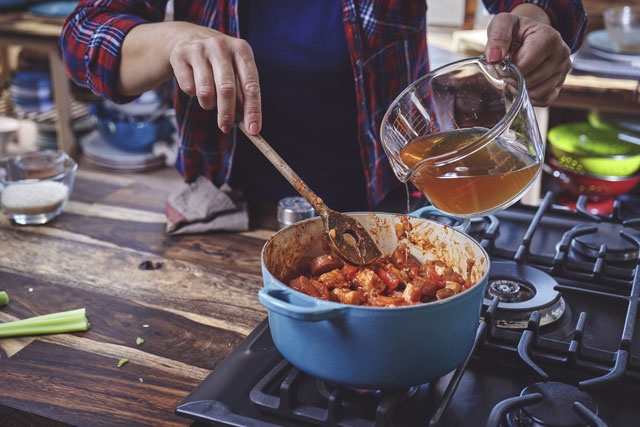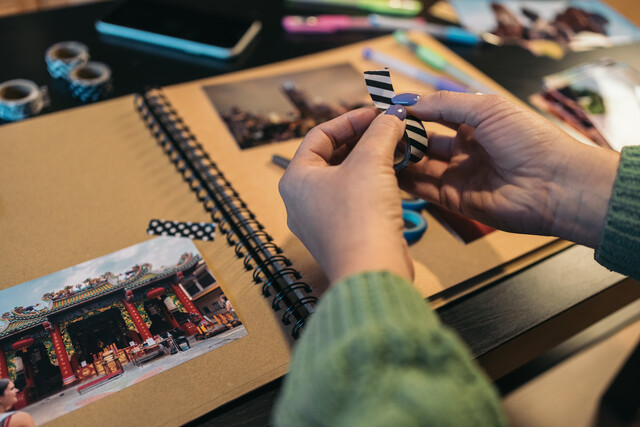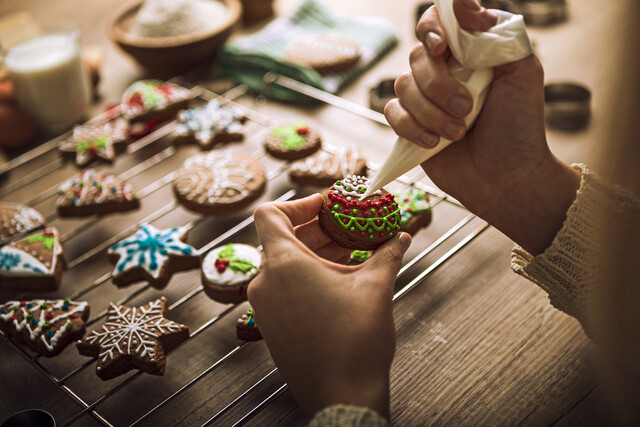Steps to a Perfect Pedicure
How many times have you removed your shoes and moaned, "Oh, my poor feet?" Busy men and women who are constantly on the move often neglect to care for their feet. It seems women's designer high-heels are getting higher and higher. Teetering around on these "shoes from hell" can and does cause damage to the feet. That's why it's so important to care for them by doing regular pedicures. The good news is starting and maintaining a foot care routine at home is easier than you think. The reward is feet that are clean, smell great and look sexy in sandals.
Since feet are covered in sweat glands and produce excess sweat (more than any part of your body), it's important to keep them clean. Sweat and bacteria multiplying on the feet cause odor. To minimize bacteria and odor, wash your feet with soap morning and night. Dry your feet thoroughly taking extra care between your toes. For a great finish, sprinkle them with a little medicated foot powder.
A pedicure should take about 45 minutes. Make the best of it, play some music, light a candle and pour yourself a beverage.
- It pays to invest in a pedicure foot bath because it is large enough for both feet, can give foot relief anytime you need it and most give a bonus massage during the soak. Foot baths run anywhere from $25.00 to $75.00. Somewhere in the mid-price range should work fine. Soak your feet in lukewarm water, not hot, water. Add a little lavender, Epsom salts or essential oil. To begin your pedicure, remove one foot from the soak and, if possible, keep the other foot in the bath until you moisturize.
- Cuticles on the feet have a tendency to grow denser than on the fingernails and require more focus. After your toes are completely dry, apply cuticle remover to the bed of each toenail, gently massaging into the skin. Wait a few minutes until it is completely dry. With an orange stick or a cuticle removing tool, push the cuticle away from the nail toward the ankle. If you have discomfort or pain, stop this part of the pedicure and move on to the next step.
- Using nail clippers, trim your nails shorter than the top of the toe and straight across. If you take nail off the sides, you could wind up with a painful "ingrown toenail." Use the coarse side of an emery board to file the rough edges from the nail.
- Soak a pumice stone in warm water before scrubbing away rough, flaky areas. Give the heel and outer side of the foot extra attention.
- Remove the other foot from the water and follow the pedicure steps for both feet.
- After completing the pedicure, moisturize, moisturize feet and legs up to the thighs. Allow the lotion to soak in. Dab a small amount of alcohol on each toenail to clean off the lotion. If you forget this step, your polish will not stay on. Not using polish? Moisturize your feet again and put on socks.
- Use a colorful polish, one of the newest shades or something that fits your mood. Use toe separators and the same polishing method as for the fingernails. Always use a basecoat. If you don't the nails could yellow from the polish. Apply topcoat at least every other day to protect your pedicure.
- The first day of your pedicure, wear open toed shoes and no pantyhose or socks for two days. Four layers of polish need adequate time to harden.
- When taking a shower that first day, don't dry your toes with a towel. Let them air dry to avoid the towel fuzzys.
- A worthy idea is to bring your own polish to the salon for touch-ups if you are not doing a home pedicure. The same applies for home pedicures. Keep your polish tightly capped in a cool place (not in the refrigerator).
- Watch your step ? you stub your toe more often than you realize. Not only does the toe rebel, but your polish chips.
- The chemicals in swimming pools, mainly chlorine, eat away at your polish.
- Always moisturize your feet when getting out of the tub or shower. Dry skin and cuticles are your pedicure's enemy.
Feet need Love Too
We are always toning and exercising our other body parts, but frequently ignoring our feet. Did you know walking can exert a pressure of more than 125,000 pounds per mile per each foot for a 120 pound person?
The above charts indicate certain areas of the feet and the corresponding area of the body. The charts are used for foot massage, acupuncture, and acupressure. Reflexologists believe the body contains an energy field or invisible life force, and when blocked it prevents healing. They claim to be able to relieve stress and pain in parts of the body through manipulation of the feet. A small example of the proposed effects of reflexology include the release of endorphins, which are natural pain killers found in the body, the promotion of lymphatic flow or the dissolving of uric acid crystals (kidney stones).
The claims are rejected by the general medical community citing a lack of scientific evidence.
There doesn't seem to be any danger when applying pressure to a certain corresponding area while doing a foot massage. For example: pressure at the top of the small toe may relieve sinus pressure, an area in the outside of the inner foot may relieve a stomach ache. Whether or not you believe in these claims, it's sometimes fun to experiment and give extra attention to those work horses attached to our ankles. Try these massage techniques:
- Before beginning the massage, soak your feet in warm water with mild soap (herbal soap is recommended) for about ten minutes. Towel dry.
- Sit on a comfortable chair and lift your right foot over your left knee to make it accessible to both hands.
- Apply a generous amount of massage oil to the foot.
- Apply your two thumbs to the upper surface of your foot approximating each other in front of the ankle. Apply pressure with both thumbs and gently slide them in a downward and outward direction.
- Next, holding your foot in your hands, place your thumbs over the sole of the foot. Apply pressure in the same downward and outward direction.
- Squeeze gently each of your toes between your thumb and index finger. Repeat these steps on the other foot.
Note: Massage oil will be absorbed through the pores of your skin. It should be of good quality and medically approved.
Exercise: Try the feel good exercise above by applying the steps for foot massage to each of your feet. If you are having a problem in a certain area of your body, see the reflexology chart and apply pressure to the corresponding area of the foot.
Foot Problems
Many people have experienced a common and contagious fungal infection called Athlete's Foot. It isn't hard to figure out how this infection got its name ? from athletes having trouble keeping their feet dry. It's characterized by pain and itchiness. Athlete's Foot can be prevented by keeping feet as clean and dry as possible. With so many of us belonging to workout gyms, it's easy to acquire the infection, so bring your own towel and flip-flops.
If you contract the infection, soak your feet at night in warm water and a few drops of essential oil (peppermint and tea tree oil are a safe bet). Dry your feet well and dust with a medicated foot powder. See a physician if the infection persists.
Nuisance corns and calluses occur in areas that rub or press against your shoes when you stand or walk. Actually, the skin in these places thicken as a way to protect your feet, but the result is painful and attractive. A pumice stone is the best investment for these conditions. Use it in the shower to prevent corns and calluses from forming. If additional pain relief becomes necessary, over the counter corn and callous pads, and salicylic acid are available. A word of caution: If you have diabetes, peripheral arterial disease, peripheral neuropathy, or circulatory problems and numbness, talk to your doctor before trying any of these treatments.
When possible wear only socks or go barefoot. If your corns and calluses are ongoing, consider finding the right footwear for your problem or see a podiatrist.
Diabetic foot problems are becoming increasingly common as more and more people are diagnosed with diabetes. Injuries to the foot of a diabetic take longer to heal and there is a high risk of infection. It's no surprise diabetic foot wounds are the leading cause of hospitalization for diabetics. Diabetic feet are simply less able to meet the challenge of maintaining healthy feet. It's always best to locate a professional manicurist who specializes in pedicures for those with diabetes.
If you're looking for ways to fatten your wallet, consider doing your own pedicures. You're in the privacy of your own home, can listen to your favorite CD or watch a movie on your own TV, and you don't have to wear those awful paper sandals out to the parking lot.
ORGANIC NAIL LOTIONS AND POTIONS
Make Your Own Lotions and Cures
Organic or home remedies are great ways to save money and rid oneself of the harmful chemicals found in today's cosmetics and lotions. Many people switch to organic skin and nail products because of allergic reactions to chemicals found in conventional product lines. If you prefer to buy your skin and nail products, look for brands that specifically say certified organic on the label. Certain name brand products contain chemicals such as parabens which are linked to breast cancer. Organic skin and nail care remedies come directly from nature and can provide the same benefits as those remedies that come from specialty and department stores.
Think of it this way. Your skin absorbs everything you put on it. It deserves the best you can give it. Why not give it the best nature has to offer such as Aloe Vera, vitamins, minerals, shea butter, herbs and fruit extracts. The next time you buy lotion or a nail product, read the label. There is no reason for a product such as cuticle oil to contain anything other than natural ingredients such as sweet almond oil, apricot kernel oil, vitamins A, D and E. Naturalists recommend some of the more harmful ingredients to avoid:
Aluminum
An ingredient found in most antiperspirants. Case studies have shown the possibility of aluminum being linked to Alzheimer's disease.
Artificial Colors
May cause hyperactivity in children, blurred vision, watery eyes and headaches. Derived from coal tar, A, C and D dyes are harmful to people who suffer from eczema and have a sensitivity to aspirin.
Isopropyl Alcohol
A drying agent from petroleum that has been linked to certain cancers
Benzoates
Used as preservative in some carbonated drinks and cosmetics, it can cause numbness in the mouth, gastric irritation and may kindle asthma attacks.
Dibutyl Phthalate
Used in hair, skin and cosmetic products to increase absorption of other ingredients. Known to cause birth defects in animals and damages to the reproductive system of men and women.
Formaldehyde
Used as a nail hardener and a preservative in cosmetic products. It is harmful to inhale and can cause a skin reaction.
This is a mere sampling of the harmful ingredients used by the cosmetic and beauty industry. Try one of these instead:
- Hand and Feet Soak � Enjoy this treatment as a relaxing soak after a long day or in conjunction with a routine mani-peti. Mix together in a jar three cups of Epsom Salts, one tablespoon of glycerin and an essential oil such as lavender, clove or peppermint. Add � to � of the mixture to warm water and soak hands and feet. Store the remainder in an apothecary jar for future use.
- Chapped Skin � Add a small amount of glycerin to rosewater (depending on how oily you prefer). Apply to face, hands, lips, etc. and pat dry.
- Dry, Flaky Skin � Apply undiluted sweet oil such as almond or apricot kernel to affected skin. Olive oil also works well. This is especially good for hands ? apply to hands and feet before bed and cover with cotton gloves and socks.
- Use a pumice stone on the areas of your feet that are dry and cracked. Follow up with a good moisturizer.
- Apply the pulp of a ripe banana to the cracked area of the heels and leave on at least ten minutes before washing off.
- Apply lemon juice to your feet for ten minutes each day until the dry, cracked area is healed. Rinse and follow up with moisturizer. Acid in the lemons helps to dissolve dry skin.
- Cracked heels can mean you are lacking in essential nutrients. Take a daily vitamin and mineral supplement and, in addition, take a tablespoon of flax seed oil or fish oil.
- Drink more water.
After you get rid of the cracked heels, Badger Balm is a wonderful preventative. It can be found in health food stores or Online.
Warts are a common problem that tend to show up more on the hands and feet. They are very contagious and should be treated immediately to prevent them from spreading. If your immune system is weak, the more likely you are to contract warts. Do not use the towels of an infected person.
Home Remedies for Warts
- Vinegar � Use a cotton ball a bit larger than the wart. Soak it in vinegar, squeeze out the excess place it over the wart and use a Band-Aid to hold it in place. Continue the process until the wart goes away (this can take anywhere from two to six weeks).
- Garlic Juice � Apply garlic juice to the wart daily and the wart should be gone within two weeks. If this doesn't work, it will at least keep the vampires away.
- Dandelion � Break open the stem or leaf of a dandelion. Touch the milky substance to the wart. Cover with a bandage. As the milk darkens, it will become sticky. Reapply the milk twice daily. The wart should be gone within three weeks.
- Nail Polish � Brush clear polish on the wart daily. The wart should be gone within two weeks.
Chemotherapy and the Nails
People undergoing chemotherapy are often upset to see the effects certain chemotherapy drugs have on their nails. Chemotherapy patients pass on their advice to other patients and many find success. It helps to keep the nails cool during chemotherapy sessions to reduce damage. If the nail areas are colder than the rest of the body, the chemotherapy drugs do not reach the nails as easily to cause damage. Some dip their fingers in ice water during treatment, others use frozen bags of vegetables on their hands and feet. There are several other things one can do to prevent nail damage and infection:
- Protect the hands with rubber gloves when doing household chores. Chemotherapy causes the skin around the nails and cuticles to dry. Harsh household chemicals may aggravate the condition.
- Definitely bring your own nail kit if you choose to use a professional manicurist. The risk of infection from unsanitary nail tools is too great. Avoid getting acrylic nails or wraps. Bacteria can grow beneath the acrylic or wrap and cause infection. Chemotherapy makes the body work harder to cure infection. It's also a good idea to remove artificial nails before undergoing chemotherapy. Nail polish is safe to wear unless a nail is damaged or falling off from an injury. Polish can even strengthen the nails, however, stay clear of nail hardeners that could cause the nails to become even more brittle.
- Hangnails are quite common when undergoing chemotherapy because the cuticles become dry and ragged. Moisturize them with cuticle cream and apply cuticle remover to remove dry skin around the nail. Do not cut or tear away hangnails.
Potions for Foot Ailments
Try this recipe the next time you have callous build-up. This is especially good for diabetics and will leave your feet feeling soft and smooth.
In a clean bowl or container, mix equal parts of petroleum jelly (Vaseline) and mineral oil. Blend by using a spoon or electric mixer. If you prefer, add a few drops of your favorite fragrance or oil. Apply the mixture to the feet and don clean socks until the lotion is absorbed.
The next time you feel the pinch of an ingrown toenail, try this natural pain reliever. It's been proven to be quite effective.
First soak your foot in warm water and antibacterial soap ? or in place of soap, use table salt instead. Keep the foot in the water for about 20 minutes. Rinse well with cool water and pat your foot dry. Apply Tee Tree Oil (a natural antiseptic) to the affected nail. If you do this daily, the ingrown toenail should return to normal.
If possible, wear sandals and avoid tight shoes. Toenails should always be cut straight across with toenail clippers.
1. Water has therapeutic effects on swollen feet. Soak your feet in lukewarm water and follow with a massage using cream or oil.
2. Stretching and foot exercises such as getting up and down on your tip-toes to the count of 20. This exercise should be performed as slowly as possible.
3. Wear shoes that fit properly. As we age, the foot changes, and you may require a larger size or width.
4. Massage a mixture of peppermint essential oil, water eucalyptus essential oil and lemon essential oil into the feet after a warm water bath.
5. If your work requires you to sit for long periods of time, get up on your feet and walk a bit, at least once every hour.
6. Elevating the feet brings relief from swelling.
Natural remedies may not work for everyone, but can give temporary relief. It's also a natural topic of conversation. People can share and compare the remedies they use for their ailments.




